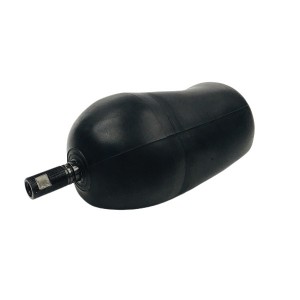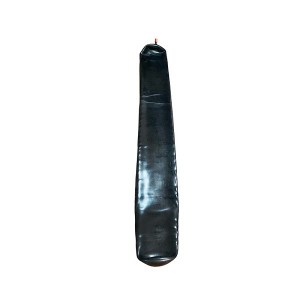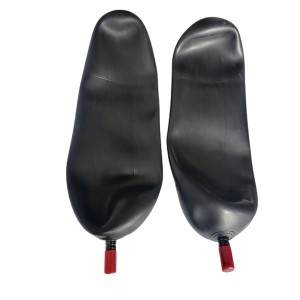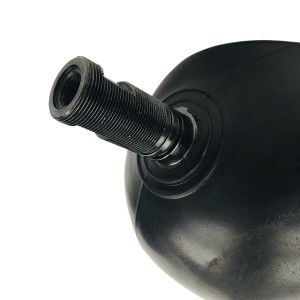In the industrial field, especially in the power generation industry with extremely high safety requirements, hydraulic systems play a vital role in various equipment. As the core component of electric energy conversion, the steam turbine requires reliable hydraulic control during its operation, and the accumulator, as an important part of the hydraulic system, can store energy and stabilize the system pressure. One of the core components of the accumulator is its internal bladder, which is used to separate hydraulic oil and inert gas. Below we will focus on the swelling phenomenon and mechanism of the NXQA-10/20-L-EH accumulator bladder commonly used in steam turbine hydraulic systems when it comes into contact with phosphate ester fire-resistant oil. Understanding this swelling mechanism is crucial to selecting suitable bladder materials and ensuring long-term stable operation of the system.
1. Structure and material properties of NXQA-10/20-L-EH bladder
According to the information provided by users, the NXQA-10/20-L-EH accumulator bladder has the following significant characteristics: oil resistance, acid and alkali resistance, flexure resistance, small deformation, and good air tightness. These characteristics indicate that the material selection has been carefully considered to adapt to the working environment of the hydraulic system. Generally, the accumulator bladder needs to withstand high pressure, high temperature and long-term contact with hydraulic oil, so its material must have excellent physical and chemical stability.

Although the specific material composition is not clearly given, it is inferred that common bladder materials such as nitrile rubber (NBR), fluororubber (FKM) or hydrogenated nitrile rubber (HNBR) may be selected based on their oil resistance, acid and alkali resistance. These rubber materials are designed to resist oil erosion and maintain their structural integrity and sealing performance.
2. Chemical properties of phosphate ester fire-resistant oils
Phosphate esters are an important fire-resistant hydraulic oil and are widely used in places with high fire safety requirements, such as aviation, metallurgy and power generation industries. Its chemical structure usually contains phosphate groups and may contain various ester side chains. Compared with traditional mineral oils, phosphate esters have good flame retardant properties, but their polarity is relatively high, which may cause them to interact with certain elastomeric materials.
The polar groups in the phosphate ester molecules enable them to interact with the polar groups or molecular chains in the rubber material. This interaction is the root cause of the swelling of the bladder material.
3. Analysis of the swelling mechanism
The swelling of the NXQA-10/20-L-EH bladder material by phosphate ester fire-resistant oil mainly involves the following two mechanisms: physical adsorption and chemical degradation.

1. Physical adsorption:
Physical adsorption refers to the penetration of phosphate ester oil molecules into the interior of the bladder material, and the intermolecular force weakens the cohesive force between the rubber molecular chains, resulting in the volume expansion of the material. The similarity and solubility principle of phosphate ester molecules and rubber materials is the main driving force for physical adsorption. If the polarity of the bladder material is close to that of the phosphate ester oil, it is more likely to swell.
After the phosphate ester oil molecules enter the rubber matrix, they will occupy the space between the rubber molecular chains, resulting in an increase in the volume of the rubber. This expansion is not the breaking or generation of chemical bonds, but a physical solvation process. The degree of swelling depends on the type, concentration, temperature of the oil and the chemical structure of the rubber material.
2. Chemical degradation:
In addition to physical adsorption, phosphate ester oil may also react chemically with the bladder material, causing degradation and swelling of the material. This chemical degradation mainly involves the following possibilities:
Interesterification reaction: If the bladder material contains ester groups (such as some types of polyester rubber), the phosphate groups in the phosphate ester oil may undergo an esterification reaction with the ester groups in the rubber, causing the chemical structure of the rubber to change, thereby causing swelling and performance degradation.

Hydrolysis reaction: Phosphate ester oil may undergo hydrolysis reaction to generate acidic substances at high temperatures or in the presence of moisture. These acidic substances may corrode the rubber material, accelerating its degradation and swelling. Although the NXQA-10/20-L-EH bladder is acid and alkali resistant, long-term contact with high concentrations of acidic substances may still cause damage to it.
Reaction with specific functional groups in rubber: Some rubber materials, such as nitrile rubber (NBR) containing unsaturated double bonds, may undergo addition or oxidation reactions with certain components in phosphate ester oil, changing the cross-linking structure of the rubber, resulting in swelling and performance degradation.
4. Effect of swelling on bladder performance
The swelling of the bladder material will have many effects on the performance of the NXQA-10/20-L-EH accumulator:
Volume change: Swelling will cause the bladder volume to increase, which may affect the volume and pressure characteristics of the accumulator. In design, the size of the bladder is precisely calculated, and excessive swelling will change its working state.
Degradation of sealing performance: Swelling may cause the sealing interface between the bladder and the accumulator shell to deform, reduce its sealing performance, and even cause leakage. Good airtightness is the key to the normal operation of the accumulator.
Degradation of strength and durability: During the swelling process, the physical properties of the rubber material may change, such as the decrease in tensile strength and tear strength, making the bladder more susceptible to mechanical stress damage and shortening its service life.
Deformation and flexural performance changes: Although the user mentioned that the deformation is small, long-term swelling may change the elastic modulus and flexural performance of the material. Repeated pressure changes and flexing may cause the swollen material to be more prone to cracks, ultimately leading to failure.
In order to ensure the long-term stable operation of the hydraulic system, when selecting and using the NXQA-10/20-L-EH bladder, the characteristics of phosphate ester fire-resistant oil must be fully considered, and appropriate measures must be taken to control swelling, such as selecting suitable materials, modifying materials, optimizing structural design, etc. A deep understanding of the swelling mechanism will help to better maintain and manage the turbine hydraulic system and ensure its safe and reliable operation.

When looking for high-quality, reliable bladder accumulators, YOYIK is undoubtedly a choice worth considering. The company specializes in providing a variety of power equipment including steam turbine accessories, and has won wide acclaim for its high-quality products and services. For more information or inquiries, please contact the customer service below:
E-mail: sales@yoyik.com
Tel: +86-838-2226655
Whatsapp: +86-13618105229
Yoyik offers various types of spare parts for steam turbines, generators, boilers in power plants:
HP accumulator MXQA-25/31.5-L-EH
GEAR BOX BW16-23
“O” type Seal ring HN 7445-75.5×3.55
Gearbox NGW-S-82-6-II
Electric butterfly valve D971X-10
nitrogen accumulator filling kit 10L
BFP Actuator Servo Valve SM4-20(15)57-80/40-10-H607H
Check valve H41W-16P
SHAFT SEAL SEALING COMPONENT M3231
Three-way valve J21W-64P
GEAR PUMP 2P82 6D G28PI-V-VS40
Electric gate valve Z941W-10P
Globe valve WJ65F-16
plug for MOOG valve 49054F014S002S
Electric stop valve J961Y-20 DN50
accumulator NXQA-25/31.5L
Solenoid Valve CXD20
Stop valve J61Y-200P
Reheater inlet plugging valve SD61H-P38.670I WC6
VALVE 73218BN4UNLVNOC111C2
valve E-ME-A-05F20
Electric stop valve J961H-400LB 25
Nitrogen Accumulator HB10/2
Stop valve J61H-320
Solenoid valve 8353G53
Electric stop valve J961Y-P5545V 12Cr1MoV
MSV active solenoid valve coil Z2804071
2 solenoid valve 5M3V410-15NC
Instrument valve J21H-200P
reciprocating piston pump 5MCY14-1B
Stop valve J61H-25P
ANEMOMETER WIND SPEED WS-5300 CA
Post time: Mar-26-2025













